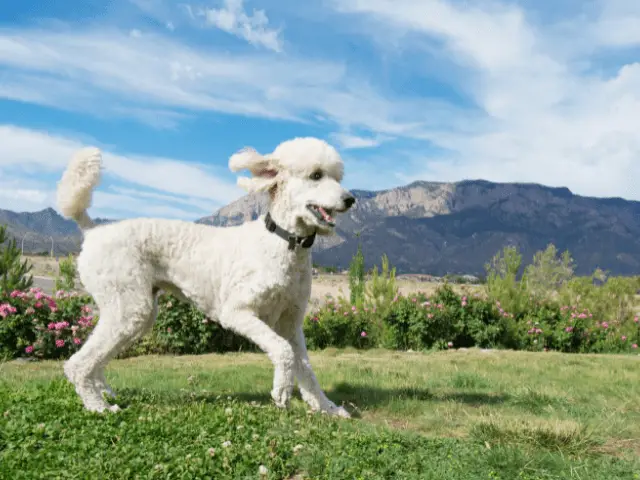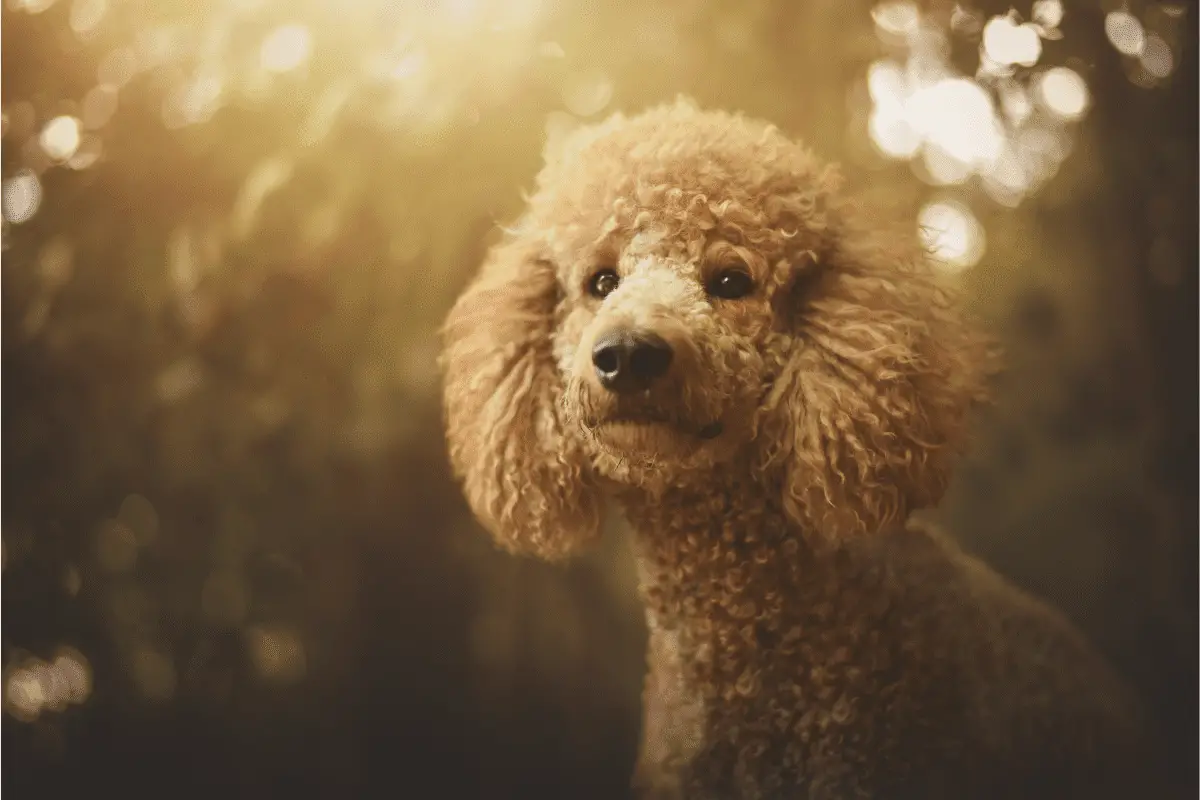Poodles are a popular breed, sought after by potential dog owners for a wide variety of reasons.
Their tightly curled hair, which has a longer growth period than normal, makes them a safer breed for people with allergies; their intelligence makes them easy to train as a service animal; and their temperament makes them a perfect match for families with children who might have trouble with a less gentle, patient breed.
But what about active, outdoorsy dog owners who want a canine companion on their adventures? Is it a good idea to go hiking with a poodle?
Do Poodles Do Well with Hikes?

In the modern day, many people imagine the poodle to be a high-maintenance show dog that needs lots of grooming and is only valuable for its looks. The miniature and toy breeds of poodles, in particular, are often seen as lap dogs with no great desire to get dirty and tired from roaming the outdoors. These ideas couldn’t be further from reality.
Poodles are a water dog, originally bred in the Middle Ages for waterfowl hunting. They love spending time outside, swimming, and tracking smaller animals. Although they are used more as a companion dog than as a hunting dog in the twenty-first century, their athleticism and drive remain instilled in their genetics.
Miniature and toy poodles, variants bred in the nineteenth and twentieth centuries for different types of work and for companionship, may require less activity than standard poodles due to their smaller size. However, they are still athletic dogs and enjoy hiking with their owners.
Miniature poodles were popularly used as circus dogs for many years, an industry which demanded its own unique athleticism from the dogs. Toy poodles were purely bred as a companion, after miniature poodles became popular companionship dogs outside of the circus industry.
This singular history makes the poodle a fun-loving, energetic dog that wants to be with their owner for any reason, including and especially athletic activities like hiking.
How Far Can You Hike with A Poodle?
Poodles are active working dogs with an impressive amount of stamina (even miniatures and toys have a lot of stamina relative to their size). As a result, they may be able to hike fairly long distances, but the appropriate distance to hike with your poodle depends on a few variables.
One of the first things to consider is age. Puppies obviously have a lot of energy, but dogs under one year of age may not be able to hike far, either because they haven’t grown to full size or because they are simply too young for that kind of activity.
Older dogs may also have issues with long distances, but in general, healthy adult poodles should be able to hike for a while.
Standard poodles, which stand at around two feet tall, may be able to hike for up to ten miles at a moderate pace. On a more intense hike, or if there is running involved, their maximum distance is closer to five miles.
Miniature poodles, which are closer to one foot tall, can hike up to five miles before they are likely to tire out. At higher intensities and speeds, they shouldn’t go more than three miles.
Toy poodles, which are under eleven inches tall, may not be the best fit for a “real” hike. They enjoy going outdoors and being active, but because they are so small, they may not be able to hike farther than a mile, which is likely to be insufficient for a person who likes to get some serious exercise on their hike.
Ideal Weather for Hiking with A Poodle

Although all poodles love outdoor activity and can enjoy at least some type of hike with their owners, the type of weather that is appropriate for hiking with a poodle depends a bit more on their size.
Standard poodles are relatively large, sturdy dogs that can withstand pretty much any weather their owner is willing to put up with. They are the type of poodle that was originally bred for hunting waterfowl, so they don’t typically mind water, including rain.
Depending on the temperature, they may even do well in the snow, although they can get cold if the weather is extreme. Poodle owners who live in areas that experience harsh winters may want to keep a warm or water-resistant coat for their dog in case of very cold, snowy days.
It’s also worth noting that snow tends to stick to curly poodle hair, so their paws should either be well-trimmed or protected by boots when hiking through snow.
Miniature poodles are less tolerant of cold, simply because of their size. It’s harder for their smaller bodies to keep them warm, and because their bellies are much closer to the ground than those of standard poodles, they feel the cold faster.
They can still hike in rainy and even snowy weather, but if you feel even a bit cold outside, your mini poodle probably does, too. Keep protective pup gear for rain and/or snow on hand if you intend to hike with them in that kind of weather.
Toy poodles are too small to deal with very cold weather. You should definitely protect your toy poodle with a coat and rain or snow boots when taking them out in such weather, and it’s probably best to avoid attempting a hike with them unless it’s sunny out.
In summer months, or any time there is hot weather, your poodle may tend to overheat, regardless of their size, because of their thick curly hair.
Be sure to keep them at an appropriate length for the weather or time of year, and always have fresh water available to them when on a hike. Take a break at the halfway point, or whenever it appears necessary, to give your pup the opportunity to drink.
Reactivity and Prey Drive
Poodles have a lot of energy, and they were originally bred for hunting. This means that, to some extent, a prey drive is to be expected; it’s quite literally in their genes to retrieve small animals for their owners, and they don’t necessarily know that you aren’t hunting when you go for a hike.
Fortunately, because poodles are so intelligent and trainable, you should have little trouble managing this prey drive so that your hikes with them can go smoothly.
You may choose to train your poodle to respond to cues that will allow you to calm them down when they see a potential prey animal, to automatically lie down or look at you when they see something that they want to chase, or even to care less about the presence of potential prey animals.
No matter what training path you choose, and whether you train your dog on your own or with the help of a professional trainer, the dog is likely to be receptive, and that obstacle will be removed from hiking with them in no time.
Most poodles get along well with other dogs and with people, so you’re not likely to have much of a problem in terms of reactivity to those you might encounter while on hikes. However, if you do have a reactive poodle, they will be easy to train so that this reactivity becomes manageable, just like their prey drive.
Grooming

If you have a poodle, then you probably know about the grooming they require, but it’s even more important to groom your poodle properly if you’re regularly taking them on hikes.
A poodle’s coat can be appropriate for any weather, but only if maintained correctly. It should be kept short when the weather is warm, and can be grown out when the weather is cold, but it must be brushed regularly in order for it to provide significant protection against the lower temperatures.
The hair on their paws and in between the paw pads should be kept short regardless of the weather, so that they can cool off in the heat and keep water or snow out of their toes in the cold.
Another aspect of grooming to consider when hiking with a poodle is the possibility that things will get stuck in their hair. For example, sticks and leaves that won’t latch on to a short-haired dog will often get trapped in the curly coat of a poodle.
During the muddy season, mud can also get stuck in their hair or in-between their paw pads. Unless the trail you hike on is very well-maintained with a path that is relatively clear, it’s a good idea to give your poodle a quick brushing after returning from a hike.
This will give you the chance to remove any pieces of plants that they’ve picked up and, depending on where you live and the time of year, check for ticks or other bugs that may be present at the hiking location.
As long as you keep your pup appropriately groomed both before and after your hikes, you can enjoy making those outdoor adventures a regular part of your schedule together.

